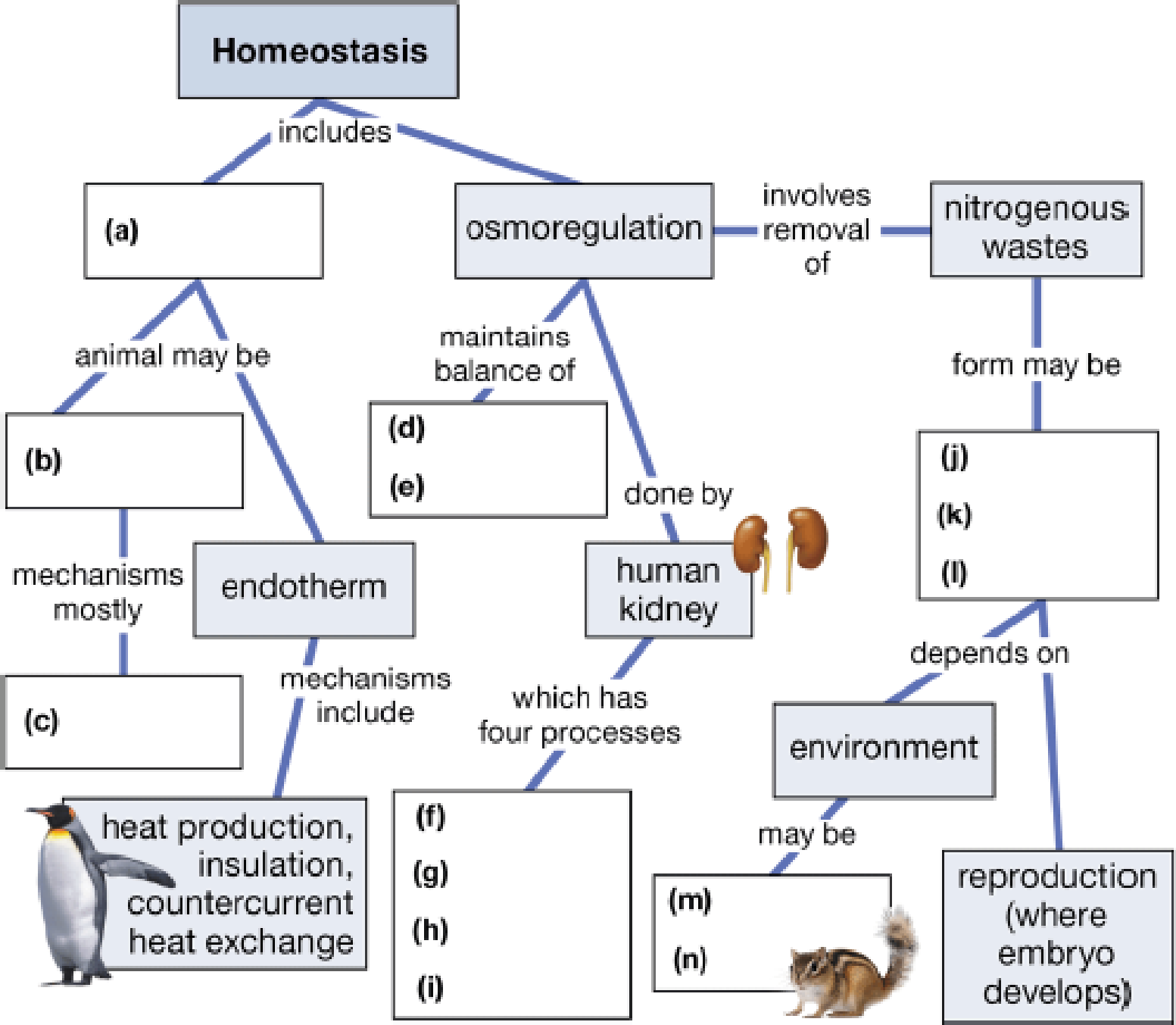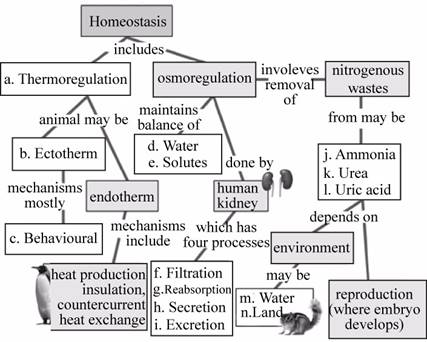
Concept explainers
Complete this map, which presents the three main topics of this chapter.

To complete: The given map representing the three main topics of this chapter.
Concept introduction: The processes such as thermoregulation and Osmoregulation are very essential for maintaining the homeostasis of the body.
The change in constant internal body temperature can impair the activity of enzymes and therefore, can result in death. The disturbance in osmolarity can have similar effects.
Answer to Problem 1CC
Pictorial representation: Fig.1 shows the completed map representing the three main topics of this chapter.

Fig.1: Three main topics of the chapter.
Explanation of Solution
(a)
Correct answer: Thermoregulation
Explanation: Thermoregulation is a homeostatic mechanism in animals that maintains the constant internal body temperature regardless of external temperature fluctuations. Hence the correct answer is thermoregulation.
(b)
Correct answer: Ectotherm
Explanation: Ectotherms are those animals that can regulate their body temperatures by gaining heat from surroundings. Hence, the correct answer is ectotherm.
(c)
Correct answer: Behavioral
Explanation: Ectotherm maintains constant body temperatures by behavioral responses such as huddling, migration and sun bathing. Hence, the correct answer is behavioral response.
(d)
Correct answer: Water
Explanation: The Osmoregulation is a process by which an organism maintains balance of water in the body. Hence, the correct answer is water.
(e)
Correct answer: Solutes
Explanation: The Osmoregulation is a process by which an organism maintains balance of solutes in the body. Hence, the correct answer is solutes.
(f)
Correct answer: Filtration
Explanation: It is one of the four processes by which the kidneys produce urine. In this process, the hydrostatic pressure in the glomerular capillaries drives the filtration of blood. Hence, the correct answer is filtration.
(g)
Correct answer: Reabsorption
Explanation: It is one of the four processes by which the kidneys produce urine. In this process, the essential nutrients such as glucose, amino acids, salts and water are reabsorbed into the blood. Hence the correct answer is reabsorption.
(h)
Correct answer: Secretion
Explanation: It is one of the four processes by which the kidneys produce urine. In this process, the extra ions, drugs and other harmful substances are secreted into the renal tubules and are excreted out of the body. This process takes place in the distal convoluted tubules. Hence, the correct answer is secretion.
(i)
Correct answer: Excretion
Explanation: It is the last process in the urine production. In this process, the harmful waste substances are eliminated from the kidneys in the form of urine. Hence, the correct answer is excretion.
(j)
Correct answer: Ammonia
Explanation: Ammonia is one of the form in which nitrogenous waste can be eliminated. The excretion of nitrogenous waste in the form of ammonia generally occurs in aquatic organisms. Hence the correct answer is ammonia.
(k)
Correct answer: Urea
Explanation: Urea is one of the form in which nitrogenous waste can be eliminated. Many mammals including humans, amphibians and some bony fishes excrete urea. Hence the correct answer is urea.
(l)
Correct answer: Uric acid
Explanation: Uric acid is one of the form in which nitrogenous waste can be eliminated. Many birds, some reptile and some insect excrete uric acid. Hence the correct answer is uric acid.
(m)
Correct answer: Water
Explanation: The form in which the nitrogenous waste is to be excreted depends on the environment, which can be water. Hence the correct answer is water.
(n)
Correct answer: Land
Explanation: The form in which the nitrogenous waste is to be excreted depends on the environment, which can be land. Hence the correct answer is land.
Want to see more full solutions like this?
Chapter 25 Solutions
Campbell Biology: Concepts and Connections
- Choose correct answers Females of Spongy Moth (Lymantria dispar dispar) have no wings. Spongy Moth is a native species. | Both Spongy Moth and Satin Moth belong to the same subfamily. Eastern Spruce Budworm (Choristoneura fumiferana) feed on both fir and spruce. Eastern Spruce Budworm is an introduced species.arrow_forwardDiscuss how global warming might make it harder for the wind/currents to mix the different ocean layers. Apply that knowledge to how global warming would affect marine life species, such as mollusks and limpets. Please answer both parts. break down each idea and explain.arrow_forwardexample of a nasogastric tube feeding question with rationalearrow_forward
- answer question in imagearrow_forwardChoose correct answers Eastern Spruce Budworm (Choristoneura fumiferana) exclusively feeds on spruce. Tennessee Warbler and Cape May Warbler have positive associations to Spruce Budworm outbreaks. Eastern Spruce Budworm outbreaks occur every 10 years. BTK is effective to control Spruce Budworm pupae and adults.arrow_forwardLabel the dorsal, pectoral, pelvic, and anal fins on your sketch (no need to sketch). Based on their relative positions, what can you say about the evolutionary history of the species represented by the specimen? The specimens are indian mackerel, milkfish, and mackerel scad. Pls search the pic of the mackerel scad as bartleby limits the pic upload in 2 only.arrow_forward
- Health Safety And Nutrition F/Young ChildHealth & NutritionISBN:9781305144767Author:MAROTZPublisher:Cengage
- Essentials of Pharmacology for Health ProfessionsNursingISBN:9781305441620Author:WOODROWPublisher:CengageCase Studies In Health Information ManagementBiologyISBN:9781337676908Author:SCHNERINGPublisher:Cengage
 Biology Today and Tomorrow without Physiology (Mi...BiologyISBN:9781305117396Author:Cecie Starr, Christine Evers, Lisa StarrPublisher:Cengage Learning
Biology Today and Tomorrow without Physiology (Mi...BiologyISBN:9781305117396Author:Cecie Starr, Christine Evers, Lisa StarrPublisher:Cengage Learning





